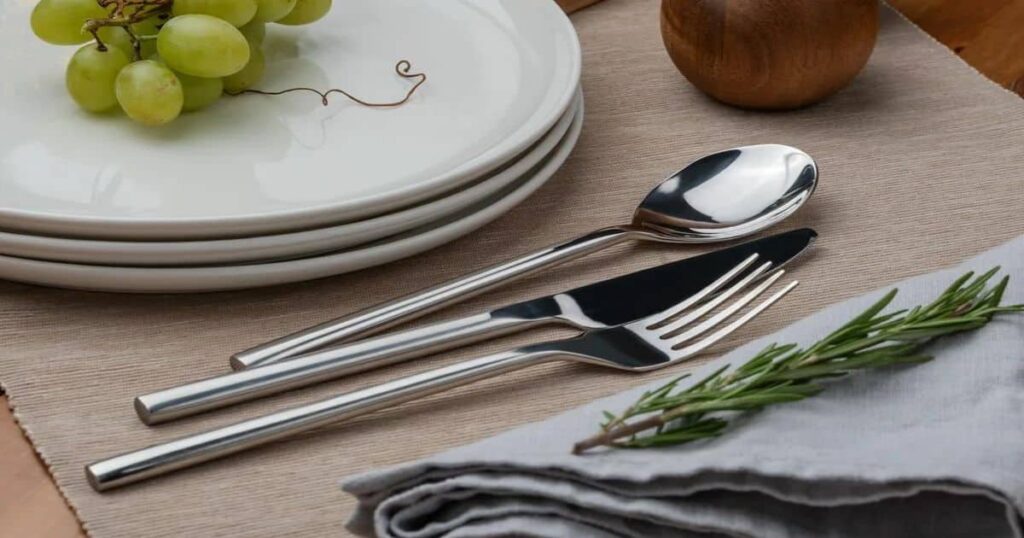Introduction
Have you ever felt flustered at a formal dinner, unsure of where to place your napkin? Or wondered why etiquette dictates certain napkin placements and usages? Proper napkin etiquette may seem like a trivial detail, but it’s a hallmark of refined dining manners.
According to a survey by the Culinary Institute of America, 63% of Americans rate a person’s table manners as the most evident sign of their etiquette and manners. Napkin placement is a subtle yet crucial aspect of displaying good manners and making an excellent impression.
We’ll unravel the mysteries behind napkin etiquette, exploring traditions, modern adaptations, and cultural nuances. Get ready to elevate your dining experience!
Traditional Table Setting Etiquette
In the realm of formal, full-service dining, traditional etiquette dictates precise napkin placement. The napkin should be neatly folded and placed to the left of the place setting, parallel to the plate’s edge. This positioning allows for easy access with the left hand while keeping the right hand free for utensils.
The rationale behind this tradition dates back to the Renaissance era when noblemen would tuck large linen napkins into their belts or collars to catch crumbs and spills. As table settings became more structured, the napkin migrated to the left side, within reach of the non-dominant hand.
In a traditional table setting, the napkin may also be placed on the charger (service plate) underneath the forks, creating a visually appealing presentation. However, this placement is typically reserved for more formal affairs, such as weddings or state dinners.
Modern Dining and Napkin Placement
While traditional etiquette still holds significance, modern dining has embraced a more relaxed approach to napkin placement. In casual settings, it’s acceptable to place the napkin on the center of the place setting, either folded or as a napkin ring.
Additionally, regional variations exist within the United States. In some areas, particularly the southern states, it’s common to find the napkin placed to the right of the plate, rather than the left. This adaptation likely stems from the influence of European dining customs.
Cultural Differences in Napkin Placement
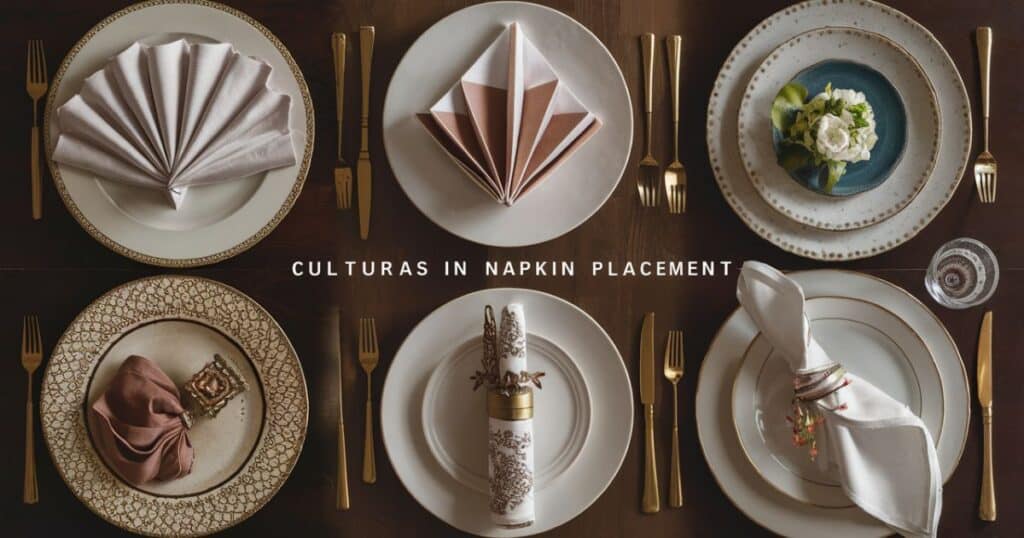
Napkin etiquette extends beyond regional variations, with distinct cultural differences worldwide. For instance, in many Asian cultures, such as Chinese and Japanese, the napkin is typically placed on the table beside the plate or folded into a decorative shape.
In some Middle Eastern countries, like Saudi Arabia, the napkin is often placed on top of the plate, as it’s considered disrespectful to place items directly on the table.
Understanding these cultural nuances is essential when dining in different parts of the world, as it demonstrates respect for local customs and traditions.
The History of Napkin Etiquette
The origins of napkin etiquette can be traced back to ancient civilizations, where wealthy individuals would use small pieces of cloth to wipe their hands and faces during meals. As dining practices evolved, so did the use of napkins.
During medieval times, large linen cloths known as “napkins” were shared among diners, leading to unsanitary conditions. It wasn’t until the Renaissance period that individual napkins became more commonplace, primarily among the noble classes.
Etiquette surrounding napkin usage and placement gained prominence during the 18th and 19th centuries, as upper-class society placed greater emphasis on refined manners and proper table settings. Numerous etiquette guides and rulebooks were published, solidifying napkin etiquette as a crucial aspect of dining decorum.
Read More: Mastering the Art of North East Facing Gardens: Uncovering the Pros and Pitfalls
Where is the napkin supposed to go?
The proper placement of the napkin depends on the occasion and the level of formality:
- Formal Occasions: For formal dinners, weddings, or upscale events, the napkin should be placed to the left of the place setting, parallel to the plate’s edge.
- Casual Dining: In more casual settings, such as family dinners or informal gatherings, the napkin can be placed on the center of the plate or folded into a napkin ring.
- Regional Variations: In some regions, particularly the southern United States, it’s acceptable to place the napkin to the right of the plate.
Regardless of the occasion, the napkin should be within easy reach and placed in a way that doesn’t interfere with other tableware or create a cluttered appearance.
What side does the napkin go on when setting a table?
According to traditional etiquette, the napkin should be placed to the left of the place setting, parallel to the plate’s edge. This positioning allows for easy access with the left hand, while keeping the right hand free for utensils.
By following this convention, you demonstrate refined manners and respect for dining traditions.
Why does the napkin go on the left?
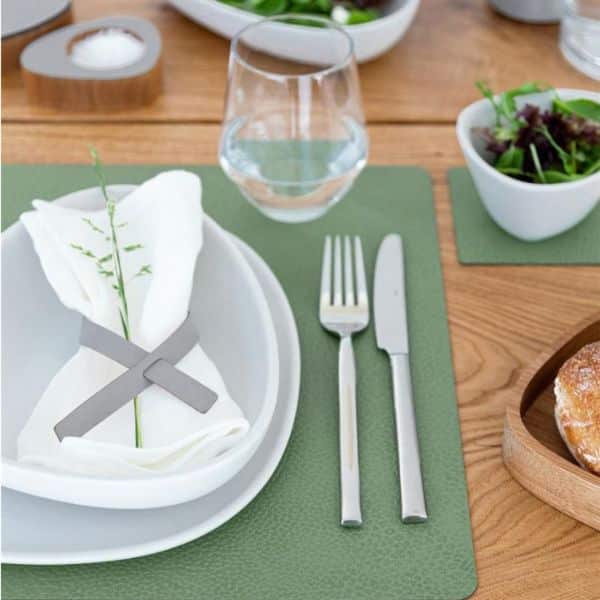
The rationale behind placing the napkin on the left side of the place setting stems from historical and practical reasons:
- Accessibility: Most people are right-handed, so placing the napkin on the left side allows for easy access with the non-dominant hand.
- Utensil Clearance: With the napkin on the left, the right hand remains free to handle utensils without any obstructions.
- Crumb Catching: Historically, napkins were tucked into collars or belts to catch crumbs and spills. Placing the napkin on the left side facilitated this practice.
- Tradition: Napkin placement on the left has been a long-standing tradition in Western dining etiquette, stemming from Renaissance-era practices.
While modern dining has relaxed some rules, adhering to this convention showcases your knowledge of proper etiquette and respect for established traditions.
Why doesn’t the napkin belong under the fork(s)?
While it may seem like a convenient placement, etiquette dictates that the napkin should not be placed under the forks or other utensils. There are a few reasons for this:
- Hygiene Concerns: Placing the napkin under utensils that will come in direct contact with food can transfer germs or lint from the napkin onto the utensils.
- Visual Aesthetics: A napkin placed under forks can create a cluttered and disorganized appearance, detracting from the table setting’s visual appeal.
- Tradition: Traditional table setting etiquette dictates that the napkin should be placed separately from the utensils, either to the left of the place setting or on the service plate.
However, there are exceptions to this rule. In some formal settings, such as state dinners or high-end restaurants, the napkin may be placed on the charger (service plate) underneath the forks as part of an elaborate table presentation.
What side does the napkin ring go on?
If you’re using napkin rings, the proper placement is to the left of the place setting, parallel to the plate’s edge. The napkin should be neatly folded and inserted into the ring, creating a decorative touch to the table setting.
Napkin rings not only add a touch of elegance to the table but also help keep the napkin neatly folded throughout the dining experience.
When should you unfold the napkin?
The appropriate time to unfold your napkin depends on the level of formality and the lead of the host or hostess:
- Formal Occasions: At formal dinners or events, it’s customary to unfold your napkin only after the host or hostess has unfolded and placed theirs on their lap. This signals the start of the meal.
- Casual Dining: In more casual settings, such as family dinners or informal gatherings, it’s generally acceptable to unfold your napkin and place it on your lap as soon as you’re seated.
Regardless of the occasion, it’s important to unfold the napkin gently and discreetly, avoiding any sudden or forceful movements that could disrupt the dining experience or distract others.
Where does the napkin go when you leave the table?
The appropriate placement of your napkin when leaving the table depends on whether it’s a temporary absence or the conclusion of the meal:
Temporary Absence: If you need to temporarily excuse yourself from the table during the meal, the napkin should be loosely folded and placed on the left side of your place setting. This signals to the server that you haven’t finished your meal and will be returning.
Never place a used napkin on the table, as this is considered unsanitary and disrespectful to the dining surface.
End of the Meal: At the conclusion of the meal, the napkin should be loosely folded and placed on the left side of your plate, or on the table to the left of your place setting. This indicates to the server that you have finished your meal.
In more formal settings, it’s customary to place the loosely folded napkin on the table to the left of your plate, rather than directly on the plate itself.
Avoid wadding up or crumpling the napkin, as this is considered poor manners. Remember, the napkin should be treated with the same care and respect as the other tableware.
Napkin Usage
Proper napkin usage is just as important as placement. Here are the etiquette guidelines for using your napkin before, during, and after dining:
Before Dining
- As soon as you’re seated, unfold your napkin and place it on your lap. This signals that you’re ready to begin the meal.
- If attending a formal event, wait for the host or hostess to unfold their napkin before doing so yourself.
- Never snap, shake, or vigorously unfold your napkin, as this can be disruptive and impolite.
During Dining
- Use your napkin to gently dab or blot your mouth, not wipe or rub vigorously.
- If you need to leave the table temporarily, loosely fold your napkin and place it on the left side of your place setting.
- Never use your napkin to wipe your nose, clean your plate, or brush away crumbs from the table.
- If you drop your napkin on the floor, discreetly ask the server for a clean one.
After Dining
- At the end of the meal, loosely fold your napkin and place it on the left side of your plate or on the table to the left of your place setting.
- Never wadding up or crumpling the napkin, as this is considered poor manners.
- If attending a formal event, wait for the host or hostess to remove their napkin from their lap before doing so yourself.
By following these simple guidelines, you’ll demonstrate impeccable napkin etiquette and make a positive impression throughout the dining experience.
Read More: What Number Should My Fridge Be On Between 1-7? The Ultimate Guide
The Art of Napkin Folding
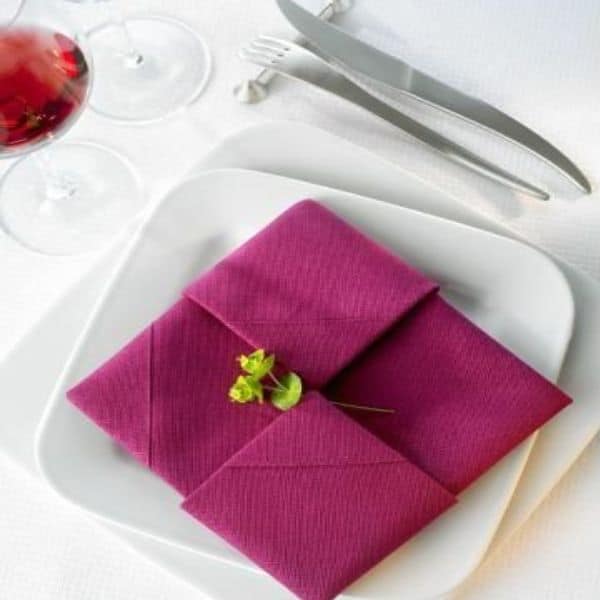
While proper napkin placement and usage are essential, napkin folding can elevate the dining experience to an art form. Decorative napkin folds not only add a touch of elegance to the table but also showcase your attention to detail and creativity.
Here are a few popular and visually stunning napkin folds to consider:
- The Lily Fold: This delicate fold resembles a blooming flower and is perfect for formal occasions or adding a touch of whimsy to your table setting.
- The Bishop’s Hat: A classic and recognizable fold, the Bishop’s Hat is a visually striking option that adds a playful element to the table.
- The Rosebud Fold: As the name suggests, this intricate fold creates a rosebud-like shape, making it an excellent choice for romantic dinners or special occasions.
- The Pyramid Fold: Simple yet elegant, the Pyramid Fold is a timeless option that can complement a variety of table settings.
To achieve these stunning folds, you may need to practice and refer to video tutorials or step-by-step guides. But the effort is well worth it, as a beautifully folded napkin can transform an ordinary table setting into a work of art.
Napkin Etiquette for Special Occasions
While the basic principles of napkin etiquette remain consistent, certain special occasions may call for additional considerations:
- Weddings: At weddings, napkins are often elaborately folded and placed on chargers or plates, creating a visually stunning tablescape. The napkin fold and placement may also complement the wedding’s theme or color scheme.
- Holiday Dinners: During holiday gatherings, such as Thanksgiving or Christmas, napkins may be folded into festive shapes or incorporate seasonal elements like evergreen sprigs or cinnamon sticks.
- Formal Ceremonies: For events like graduations, awards ceremonies, or formal banquets, napkins are typically folded in a simple yet elegant manner and placed on the left side of the place setting.
In these instances, it’s essential to follow any specific instructions provided by the event organizers or hosts regarding napkin placement and etiquette.
Kid-Friendly Napkin Etiquette
Teaching children proper napkin etiquette from an early age can instill valuable manners and dining habits that will serve them well throughout their lives. Here are some tips for making napkin etiquette approachable and fun for kids:
- Lead by Example: Children learn best through observation. Consistently demonstrate proper napkin placement and usage during family meals.
- Make it Engaging: Involve kids in the napkin folding process, teaching them simple folds like the Pyramid or the Mitre. This turns etiquette into a creative activity.
- Use Colorful or Patterned Napkins: Kids may be more inclined to use napkins if they feature vibrant colors or fun patterns that appeal to their interests.
- Praise and Encourage: When your child exhibits good napkin manners, praise their efforts. Positive reinforcement goes a long way in establishing lasting habits.
- Be Patient and Consistent: Like any skill, mastering napkin etiquette takes time and practice. Be patient and consistently reinforce the lessons during every meal.
By making napkin etiquette a fun and interactive experience, you’ll help your children develop valuable dining manners that will serve them well throughout their lives.
Napkin Etiquette in Fine Dining Restaurants
When dining at upscale, fine dining establishments, napkin etiquette takes on heightened importance. These guidelines will help you navigate the intricacies:
- Follow the Lead: Observe the server or host carefully. They may provide specific instructions or guidance on napkin placement and usage.
- Unfold Discreetly: Gently unfold your napkin and place it on your lap without any sudden or disruptive movements.
- Avoid Excessive Use: While napkins are essential for blotting your mouth, avoid excessive or unnecessary use, as this can be seen as disruptive in a fine dining setting.
- Napkin Placement During Courses: If multiple courses are served, it’s generally acceptable to place your loosely folded napkin on the table to the left of your plate between courses.
- Signal the End: At the conclusion of the meal, place your loosely folded napkin on the table to the left of your plate, signaling to the server that you’ve finished.
- Observe Others: If unsure, discreetly observe the napkin etiquette of other diners or the restaurant staff to ensure you’re following the established protocols.
By adhering to these guidelines, you’ll demonstrate your understanding of refined dining etiquette and make a positive impression at even the most upscale establishments.
Practical Napkin Etiquette for Everyday Meals
While formal napkin etiquette is essential for special occasions, it’s also important to practice good manners during everyday, casual meals at home. Here are some practical tips:
- Use a Napkin: Even for a quick snack or casual meal, make it a habit to use a napkin to catch crumbs and spills.
- Placement: For family dinners or casual gatherings, it’s generally acceptable to place the napkin on the center of your plate or in a napkin ring.
- Lap or Table: You can choose to either place the napkin on your lap or keep it on the table, folded or in a ring, and use it as needed.
- Teach by Example: Use everyday meals as an opportunity to model proper napkin etiquette for your children or guests.
- Cleanliness: Always use a clean napkin for each meal and avoid reusing a soiled napkin.
By incorporating these simple practices into your daily routine, you’ll not only maintain a tidy dining area but also instill good habits that can seamlessly translate to more formal occasions.
Napkin Etiquette Myths and Facts
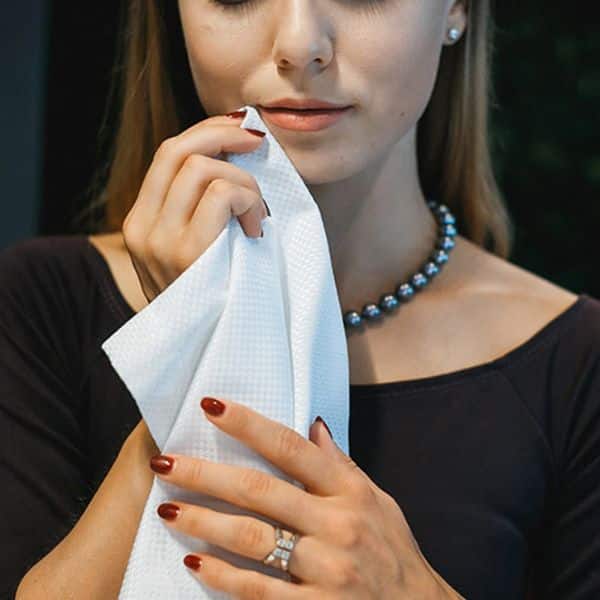
While napkin etiquette may seem straightforward, several myths and misconceptions persist. Let’s separate fact from fiction:
Myth: The napkin should always be placed on the left side of the plate. Fact: While traditional etiquette dictates placing the napkin on the left, modern and regional variations allow for the napkin to be placed in the center of the place setting or even on the right side.
Myth: It’s acceptable to use the napkin to wipe your mouth vigorously. Fact: Proper etiquette dictates that napkins should be used to gently dab or blot the mouth, not wipe or rub vigorously.
Myth: It’s okay to use the napkin to clean your plate or brush away crumbs from the table. Fact: Napkins are intended for personal use only, not for cleaning plates or surfaces. This is considered unsanitary and disrespectful to the dining area.
Myth: If you drop your napkin on the floor, you should discreetly pick it up and continue using it. Fact: If your napkin falls on the floor, you should discreetly ask the server or host for a clean replacement napkin.
Myth: Napkin etiquette is only important at formal events or fancy restaurants. Fact: While napkin etiquette is particularly crucial at formal occasions, practicing good manners with napkin usage is essential for everyday meals and casual gatherings as well.
By separating these myths from facts, you can confidently navigate napkin etiquette in any dining situation and make a positive impression with your impeccable manners.
FAQ’s
What side does cutlery go on?
According to traditional etiquette, cutlery should be placed on the right side of the plate, with the knife blade facing inward and the fork prongs facing up.
Do napkins go on left or right?
The proper placement for napkins is on the left side of the place setting, parallel to the plate’s edge. However, modern and regional variations may allow for napkins to be placed in the center or on the right side.
What side does the fork and knife go on?
The fork should be placed on the left side of the plate, with the knife on the right side, blade facing inward.
Does salad plate go on left or right?
The salad plate, or bread and butter plate, is typically placed on the left side of the place setting, above the forks.
What side does the glass go on?
Glasses, whether for water, wine, or other beverages, should be placed on the right side of the place setting, above the knife and spoon.
Remember, while these guidelines are based on traditional etiquette, it’s always best to observe the specific protocols of the dining establishment or event you’re attending.
Conclusion
Mastering napkin etiquette may seem like a trivial detail, but it’s a crucial aspect of refined dining manners that can make a lasting impression. From understanding the historical significance of napkin placement to navigating the nuances of modern and cultural variations, this comprehensive guide has equipped you with the knowledge to navigate any dining situation with confidence.
Whether you’re hosting a formal dinner party or enjoying a casual family meal, remember to place your napkin thoughtfully, use it discreetly, and treat it with the same care and respect as the other tableware. By doing so, you’ll demonstrate your understanding of proper etiquette and make a positive impression on those around you.
So, the next time you dine out or host a gathering, embrace the art of napkin etiquette. It’s a small gesture that speaks volumes about your attention to detail and commitment to creating a refined and enjoyable dining experience for all.

